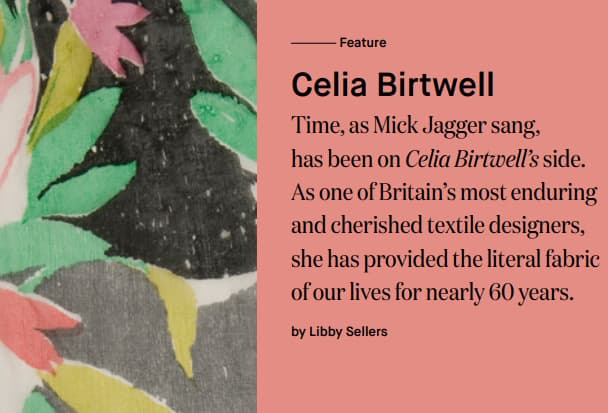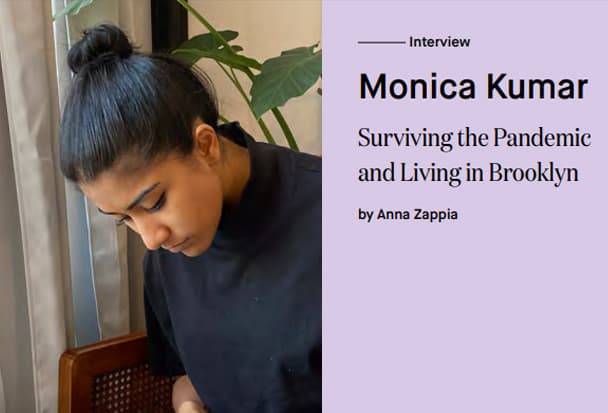With designs worn by everyone from Jagger to Talitha Getty and Kate Moss, her printed gossamer chiffons, crepes and cottons — once tailored and cut into romantic dresses and shirts— defined the ethereal look of the late 1960s and 1970s. When her focus turned to interiors in the 1980s, creating prints for walls, windows and upholstery, her distinct motifs were swathed across middle class homes and luxury hotels alike. Her more recent return to fashion, with sell-out collections for high-street retailer Topshop and collaborations with Cacharel and Valentino, kept her patterns on permanent repeat. And while her role at the epicenter of London’s creative beau monde has been downplayed, Birtwell is celebrated the world over for her part in David Hockney’s 1971 painting “Mr and Mrs Clark and Percy”.
“Being backstage at one of Clark’s shows was like being at the best party in London with all the most beautiful people.” Though perhaps this was a harbinger of events to come”
- Celia Birtwell
On the 50th anniversary of that portrait, one of Tate Britain’s most visited works, Birtwell reminisces on her decades-long friendship with Hockney, “I think he was a little intrigued by me and found me amusing (God knows why!). He has been a marvelous friend to me since then.” According to Hockney, Birtwell’s face is a ‘rarity’, revealing “her intuitive knowledge and her kindness, which I think is the greatest virtue. To me, she’s such a special person.” As a testament to their relationship, Hockney has portrayed Birtwell dozens of times across a variety of media. Given this, and the continuing appeal of Birtwell’s own work, it seems particularly strange she remains better known as Tate’s ‘Mrs Clark’— ex-wife and muse to the late fashion designer Ossie. Yet it is to Ossie Clark that Birtwell credits her beginnings.
The eldest daughter of a culture-loving engineer and a seamstress, Celia Birtwell was born near Manchester in the north of England in 1941. She recalls obsessively drawing figures from a very young age and, at 13, was accepted into a technical college in Salford. Finding her artistic voice through pottery, painting and textiles, it was during these formative years she met the precociously talented Ossie at a coffee bar in Manchester. Birtwell says of the occasion, “When I met him, it all just clicked into place, and I haven’t looked back since.” Following their move to London’s then-Bohemian Notting Hill and her series of jobs as a wig maker, costumier and designer of Op Art inspired fabrics for furniture store Heals, it wasn’t until 1965, when Ossie was designing fashion collections for the hip London boutique Quorum, that Birtwell joined him in their generation-defining collaboration.
— How have you managed with the effects of the pandemic in the last year?
Taking her inspiration from the Ballets Russes, botanical sketches and the entire contents of the Victoria and Albert Museum, Birtwell designed the prints which Clark would magic into beautiful clothing. As she says, “Ossie was the most amazing pattern cutter — he could look at a person, and then cut the fabric freehand to make a perfect garment. I have never seen anything like that before or since. He used his skill to get the best out of my designs.” Their joint creations were greater than the individual parts; their glamorous, easy to-wear dresses anticipated the mood of the hippie years and attracted a jet-set following. One infamous 1970 fashion show had throngs of people banging on the doors, imploring access to the high caliber decadence within. In Jack Hazan’s 1974 documentary “A Bigger Splash,” Hockney notes “Being backstage at one of Clark’s shows was like being at the best party in London with all the most beautiful people.” Though perhaps this was a harbinger of events to come.

With more celebrity followers than fashion buyers, mixed with his increasingly self-destructive, playboy lifestyle, Ossie’s brilliant star was quick to burn out. By 1974, his marriage to Birtwell had burned away with it, leaving her and their two sons to seek retreat in Los Angeles with her friend Hockney. With his support, Birtwell eventually returned to designing and London — opening a small, eponymous shop in 1984 in her old stomping ground, Notting Hill. By then, the once down-at-heel area had begun its march towards gentrification and Birtwell’s home furnishing fabrics were perfectly positioned to cater both to Notting Hill’s influx of affluent home renovators and her own desire for “a gentler, less frantic industry” than fashion.
The shop has now morphed into an online venture overseen by her children, though Birtwell’s print collections have continued to extend across a variety of brands from high street to high end. In a way, her career has gone full circle, twice. From furnishing fabrics for Heals, to clothes with Ossie, back to furnishing fabrics (now through Blendworth Interiors) and again to fashion. While the next sweep of the circle is still to be decided, time is likely to continue being kind to Birtwell and her great, creative legacy.
Libby Sellers is a London-based writer and curator of design. Her book, “Women in Design,” was published by
Quarto in 2018.



